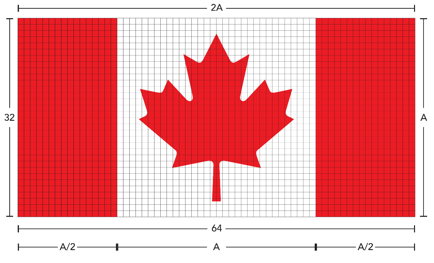Description of the National Flag of Canada
The National Flag of Canada was approved by Parliament in 1964. Ratified by a royal proclamation from Her Majesty Queen Elizabeth II on January 28, 1965, it was hoisted for the first time on February 15, 1965.
As stated in the National Flag of Canada Act, all Canadians are encouraged to proudly display the National Flag of Canada in accordance with flag protocol.
Did you know?
Since 1996, Canadians have celebrated National Flag of Canada Day every year on February 15 to mark this important date in our history.
On this page
- Technical description
- Elements of the Flag
- Colour specifications
- Educational and promotional material to celebrate the Canadian flag
Technical description
The National Flag of Canada is a red flag, twice as long as it is wide (proportion 2:1, or 64 units in length and 32 units in width or depth, as shown in the accompanying diagram). In its centre is a white square the width of the Flag, with a single stylized 11-point red maple leaf in the centre. The flag is horizontally symmetric.

Did you know?
The original design for the maple leaf on the National Flag of Canada had 13 points. This design was hard to recognize as a maple leaf when seen from a distance or floating in windy conditions, so it was changed to its current 11-point design to improve the clarity of the symbol.
In order to be considered proper representations of the National Flag of Canada, depictions of the flag must respect the correct proportions (2:1) and colours (red and white), and feature the stylized 11-point maple leaf in the centre. The flag and its maple leaf are protected symbols under the Trademarks Act.
You can download the ZIP file containing JPG, EPS and PNG versions of the National Flag of Canada and the stylized 11-point maple leaf below. JPG files are standard image files. EPS files are optimal for print products. PNG files are optimal for publication on the Web.
- Download the National Flag of Canada files (ZIP file, 2.71 Mb)
- Download the stylized 11-point maple leaf files (ZIP file, 506 Kb)
Elements of the Flag
The maple leaf
The maple leaf is one of the most recognizable symbols of Canada, and has been used to represent Canadian identity since the 19th century. It is featured on coats of arms and on flags throughout Canada, including those of the Canadian Armed Forces.
The specific design of the maple leaf that appears in the centre of the National Flag of Canada is known as the stylized 11-point maple leaf.
Learn more about the maple leaf symbol of Canada.
Red and white – Canada’s national colours
Red and white are colours that have historically been used by many nations, including those that contributed to the founding of Canada. Many Canadians have come to embrace these colours as representative of natural features prominent in some parts of our country: the white of winter snows, and the red of autumnal maple leaves.
Did you know?
The blazon, or heraldic description of the National Flag of Canada, is Gules (red) on a Canadian pale Argent (white) a maple leaf Gules. This means that the National Flag of Canada is a red flag with a white vertical band in the middle (in fact, a square), surmounted by a red maple leaf.
Colour specifications
The Canadian General Standards Board (CGSB), which falls under the Department of Public Services and Procurement Canada (PSPC), is responsible for maintaining the three National Standards of Canada for the Flag of Canada, namely:
- CAN/CGSB-98.1-2023, National Flag of Canada (Outdoor Use);
- CAN/CGSB-98.2-2023, National Flag of Canada (Indoor Use); and
- CAN/CGSB-98.3-2023, National Flag of Canada (One-Event Only Use).
These standards apply to the design, colour, material and performance requirements for their intended use as stipulated in the National Flag of Canada Manufacturing Standards Act. For example, both outdoor and indoor use flag standards provide requirements for grommets, fabric, construction and stitching.
The National Flag of Canada standards are maintained by CGSB technical committees of volunteers representing producer, user and general interest organizations. These committees strive to improve the National Flag of Canada standards at each periodic review by considering the technological advances in the production of materials and dyes used in the manufacturing of flags.
The CGSB standards may be downloaded free of charge on the Canadian General Standards Board Catalogue webpage.
Educational and promotional material to celebrate the Canadian flag
Through the Canadian Heritage Online System, you can request to receive educational items related to the National Flag of Canada by mail. Promotional items are also available for special occasions.